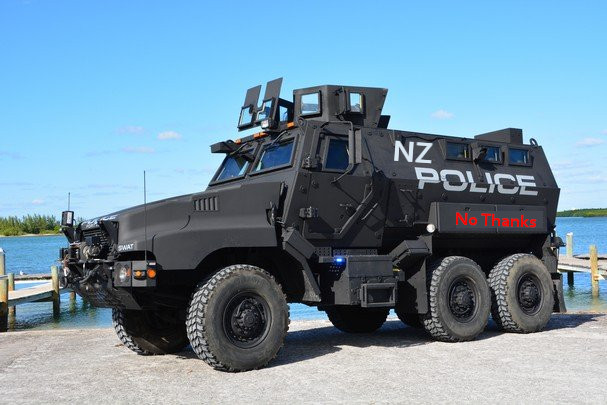If any nation or organisation places people in harm’s way as part of their role, then there is an obligation to provide the best protection possible – relevant and appropriate to the task and risk. Striking the balance between force protection and becoming disconnected from the public, however, requires great wisdom and acceptance of risk.
Judgement, in this regard, appears to be waning in some quarters of society. Some are calling this enhanced force protection ‘militarisation’ and pointing to developments within United States police forces where military weapons and armoured vehicles are becoming the new normal. It’s not only police, though, but many other agencies with legislated coercive power in New Zealand that deserve scrutiny.
The response by Police to the Christchurch mosque shooting in March 2019 is what sensitized many members of the public to increased police presence and weapon carriage. In October, Police announced the establishment of a 6-month trial of three armed response teams to be deployed in Auckland, Waikato and Canterbury. This resulted in civil protest, particularly in South Auckland, where the perceived militarisation of the Police was the primary concern. In December, Police announced the purchase of three armoured Toyota Land Cruisers for use in high-risk incidents. It is likely these vehicles were manufactured by Ares Security Vehicles in the United Arab Emirates and specifications are provided on their website.
I don’t believe that the decision of a commander on the ground should be over-ridden by those not present. Consequently, I have to have confidence that the Police Commissioner has correctly assessed the risk in making the decisions that he has. However, operational and tactical commanders in any force must be regularly reminded of the political optics of their choices and that the public must be carried along with them. Sir Robert Peel’s principles of modern policing are even more relevant today than when first spoken.
- Do we need armed police in special vehicles patrolling communities?
- Firearm Prohibition Orders to ban gangs and offenders from being around firearms
- Jacinda Ardern 'totally opposed' to all cops carrying guns, but supports new armed units
- National ponders 'Strike Force Raptor' police unit to 'harass gangs'
Militarisation goes beyond weapons and vehicles. It also can be found in intelligence collection processes, uniforms and organizational culture. It is in these aspects that the discussion needs to be extended to examine New Zealand’s Customs Service, Ministry for Primary Industries, Aviation Security Service and a host of other government agencies. In the last decade or so, there have been noticeable changes in the way that officials, particularly those holding Warrants, present themselves to the public. It has not all been positive and, in some cases, is causing significant push-back.
The most obvious change for the public is in uniforms. People could be forgiven for being confused when there are so many black and navy blue combinations out there. Does every agency hope to be ‘mistaken’ for Police? And what is the Kiwi obsession with black? Our national rugby team? It’s a colour that is associated with intimidation and aggression. Why else would most gangs wear it?
There are studies that show links between military styled or dark-coloured uniforms and increased aggression. This is unsurprising when boots increase your height by up to 50mm, your cargo pants are bloused or tucked into them, your physical presence is enhanced in a Kevlar helmet, body armour, gloves, knee and elbow pads. Civilians can’t recognize you because you’re wearing dark glasses or goggles and mask. You are covered in ‘gadgets’ hanging off a utility belt or vest. That’s intimidating even before weapons are introduced. It’s not a scenario for readily gaining information and co-operation from the public. Yet, with the exception of the helmet, knee and elbow pads, that could describe a NZ fishery officer stopping a recreational fisher and their children on any sunny Saturday.

The British army understands this. Commanders assess local conditions before swapping body armour and helmets for berets or jungle hats. Sunglasses are even seen as an impediment to communication. All this makes sense if you think how much info we get by scanning each other’s faces.
With the exception of a very few instances, most Police and government agency activities should be conducted in high-visibility mode. That’s not black or navy blue. Paramilitary-style uniform change has, coincidentally, often occurred when former military officers have been appointed to head some of these agencies. It’s a concerning trend that has nothing to do with force protection and should be addressed.
- Corrupt Auckland cop who sold police database information to gangs jailed
- Attacks on police rose in the past year with 350 assaults recorded
- We'll be watching the police's new armed response units very, very closely
Three unmarked, armoured Toyota SUVs shouldn’t really be cause for concern as long as they don’t become a ‘gateway’ asset. I’m deliberately using the language of the ‘War on Drugs’ proponents. Controlling the language means control of the debate and we should reiterate often that war is a violent, geo-political act between nation states and sometimes non-state actors. Declarations of wars on drugs or terrorism by politicians looking for a great soundbite simply fuel the potential aggression levels of the citizens we train and employ to protect society. We do not want to see any unnecessary expansion of the force protection mandate.
The U.S. experience, which is often referred to in terms of militarisation, derives from just a couple of trigger points – a violent riot in the 60s (leading to SWAT teams being formed) and the post 9/11 Patriot Act which greatly undermined civil liberties while significantly increasing the scale and power of domestic security agencies. New Zealand could end up no different unless we remain vigilant. Building public trust and confidence in security agencies should rightly fall under our national security strategy – if we had one.






